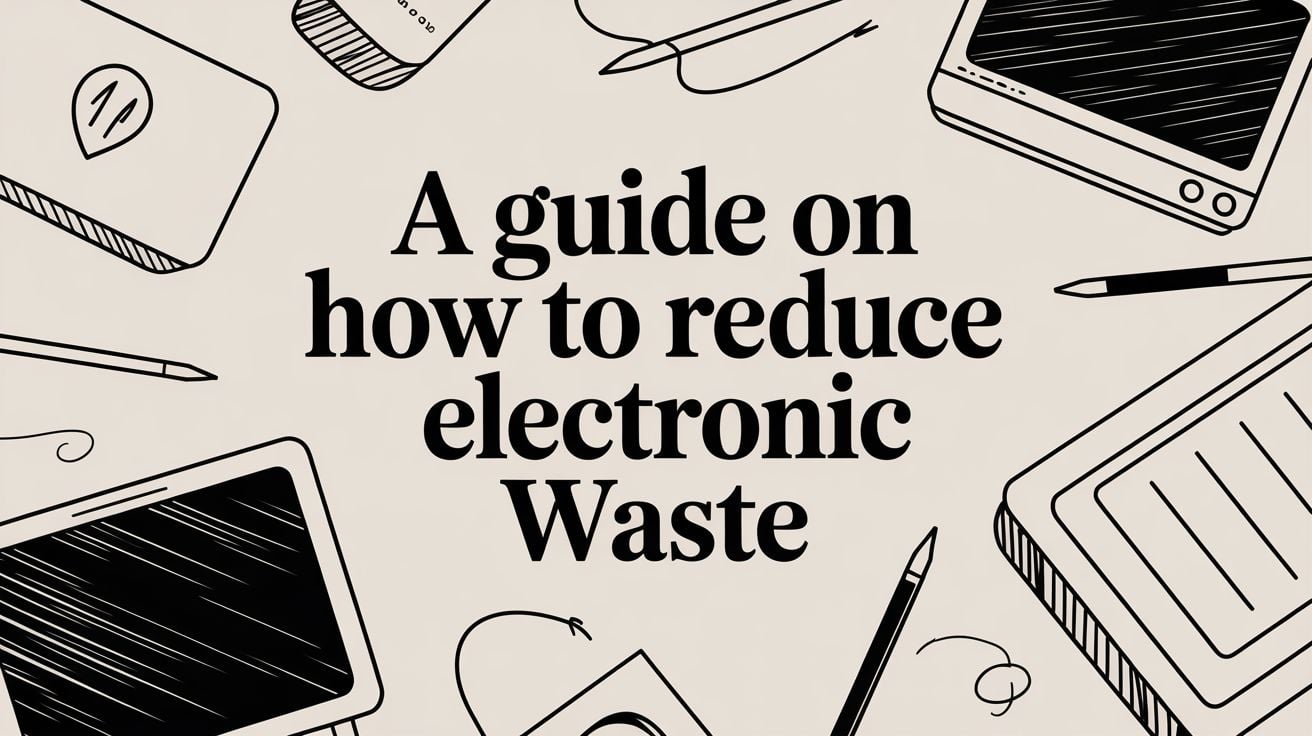
A Guide on How to Reduce Electronic Waste
You can make a real difference with electronic waste by simply repairing your devices, buying used products, and recycling your old gadgets the right way. These aren't huge, complicated actions. They're simple choices that make your electronics last longer and, most importantly, keep them out of landfills.
Why Our Gadgets Create a Growing Problem
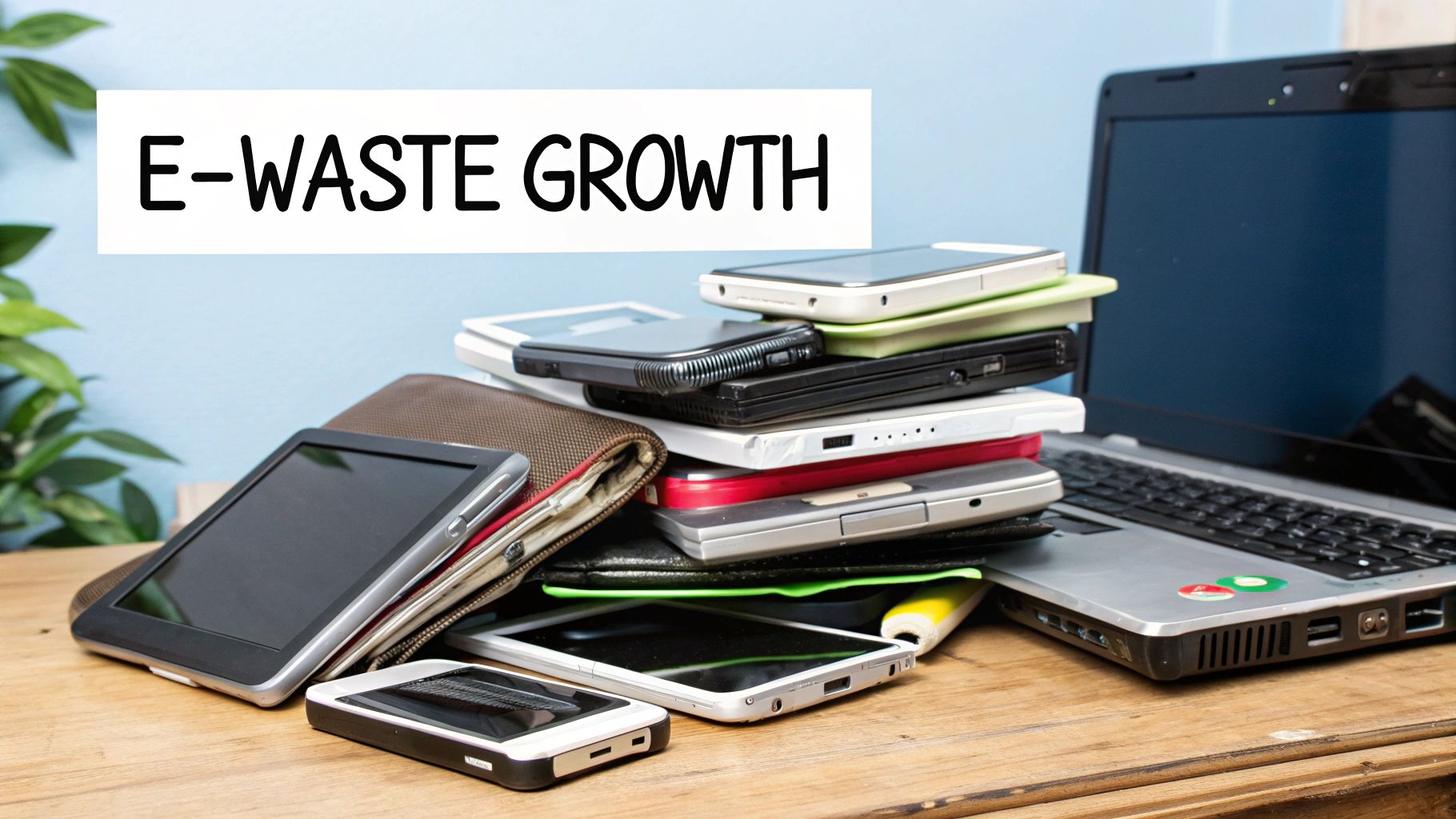
Ever notice how that brand-new smartphone starts to feel old after just a year? You're not imagining it. The constant release of new models and software updates pushes us to replace our devices more often than we need to. This cycle is what's feeding the ever-growing mountain of electronic waste, or e-waste.
This isn't about making you feel guilty for wanting a new phone. It’s about seeing the bigger picture. Every device we toss adds to a global problem with serious effects. To really get it, it's worth understanding the environmental impact of electronic waste. When our old electronics end up in a landfill, they can leak harmful stuff into the soil and water.
The Huge Scale of the E-Waste Issue
The numbers are truly shocking. By 2025, the world is expected to produce over 60 million metric tons of e-waste. That's a direct result of our desire for the latest tech. This isn't some far-off problem; it's happening right now, all around us.
The constant marketing for the “next big thing” has created a throwaway culture. Many devices are even designed with short lifespans—a shady practice where products are made to break down sooner—which makes repairs a difficult and expensive nightmare.
This cycle puts a massive strain on our planet's resources. Think about it: building a new smartphone means mining rare metals and using a ton of energy. Just by getting a little more life out of the devices we already own, we can make a real difference.
Learning how to reduce electronic waste really starts with a simple change in mindset: from replacing to taking care of what you have. Even small habits, like taking better care of your phone’s battery, can add up to prevent tons of CO2 pollution. In fact, keeping our existing devices running longer has a surprisingly big impact on reducing CO2. You can see some of the real-world data on this here: https://chargie.org/50000-chargie-devices-how-much-co2-was-saved/.
Letting this reality sink in is the first step. Once we see what's causing the e-waste problem, we can start making smarter choices that are better for our wallets and the planet.
Think Repair and Reuse Before You Recycle
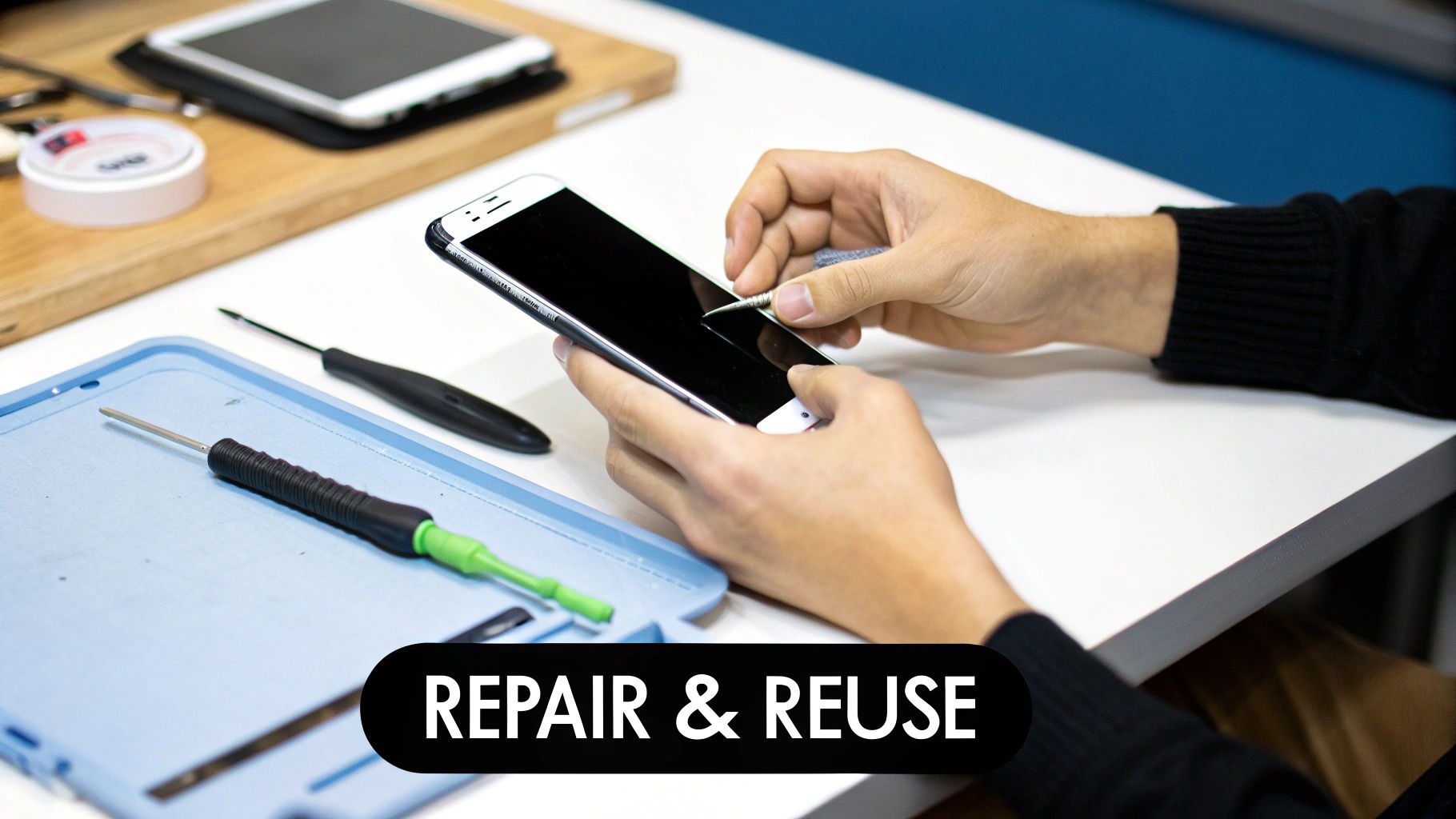
While recycling is a vital final step for any electronic device, the best way to reduce electronic waste is to stop creating it in the first place. That means changing how we think. Instead of automatically replacing a device at the first sign of trouble, we need to get back to the mindset of repairing and reusing.
It's a powerful change that not only saves you money but keeps perfectly good electronics from ending up on the scrap heap too soon.
Most of the issues that make us give up on our devices are surprisingly fixable. A cracked phone screen, a battery that can’t hold a charge, or a slow laptop often feel like the end of the line. But really, they're usually just signs that one part needs a little attention.
Before you even start looking for a replacement, let's explore your repair options.
Exploring Your Repair Options
You don't have to be a tech expert to get your gadgets fixed. Most communities have independent repair shops that can handle common problems quickly and for a good price. Supporting these local businesses is a great way to help your local economy and keep your device working for much longer.
If you’re more of a hands-on person, fixing things yourself has never been easier. Websites like iFixit have built a whole community around fixing things, offering free, detailed guides and selling affordable toolkits for everything from screen replacements to battery swaps.
- Find Local Repair Shops: A quick search for "phone repair near me" can connect you with trusted local experts who do this every day.
- Try DIY Kits: For a common problem like a weak iPhone battery, a do-it-yourself kit can be a fun and very cheap weekend project.
- Check Your Warranty: Before anything else, see if your device is still covered. It's always worth checking to see what the official warranty and services cover—you might get a free or discounted repair.
A simple battery replacement can give an old phone or laptop a new life, basically doubling how long you can use it for a small fraction of the cost of a new device. This single action is one of the best ways to reduce your personal e-waste.
Get Creative with Reusing Old Tech
Even when a device is truly too old to be your main gadget, it might still have a second life waiting. Instead of letting it gather dust in a drawer, think about how you could reuse it. This is where you can get really creative and give old tech a new, specific job.
An old tablet that can't handle the latest apps might be the perfect digital photo frame. An old smartphone can easily become a dedicated car GPS, a baby monitor, or a simple security camera for your front door.
Here are a few ideas to get you started:
- Smart Home Hub: Mount an old tablet on the wall to act as a central control panel for your smart lights, thermostat, and speakers.
- Digital Cookbook: Keep an old tablet in the kitchen to display recipes. Your main phone or tablet stays clean and out of the way.
- Dedicated Music Player: Load up an old phone with your favorite playlists and connect it to a Bluetooth speaker for a dedicated home sound system.
By choosing to repair and find clever ways to reuse, you actively break the cycle of constant replacement. This is the very heart of learning how to reduce electronic waste—making the most of what you already have.
Adopt Smart Buying Habits for a Greener Future
https://www.youtube.com/embed/R1Tawv4ImNw
Knowing how to reduce electronic waste isn't just about what you do when a device breaks. The real impact starts the moment you decide to buy something. It's about shifting your mindset from chasing the newest gadget to investing in electronics that are actually built to last.
This just means doing a little research before you buy. Look for products known for being durable and, even more importantly, easy to repair. You'll find that brands that care about making things last often get great reviews. They build their products with parts that are easy to access, which makes future fixes much easier and cheaper.
Choose Products Designed to Last
When you're shopping for a new laptop or phone, look for signs that the company cares about more than just the first sale. It's becoming more common for brands to mention their use of recycled materials in both their products and packaging—that's a good start.
Even better, look for companies with take-back programs. This is where they'll accept your old device for proper recycling when you upgrade. It's a huge sign that a company is taking responsibility for its products from start to finish.
The design itself is a major clue. Is the device built to be taken apart for repairs, or is it glued into a seamless, unfixable brick? A device designed to be opened up is a device designed to last.
Being a conscious consumer isn't about going without; it's about making smart choices. Picking a durable, repairable device over a disposable one is a powerful way to vote for a better industry with your money.
Embrace the Value of Refurbished Tech
One of the best ways to cut down on e-waste is to buy refurbished. Honestly, it's a win-win. You get a high-quality, fully working device that’s been professionally checked and restored—often with a warranty—for way less than the original price.
More importantly, you're giving a perfectly good piece of technology a second life and keeping it out of a landfill. That simple choice directly cuts down on the need for new manufacturing, which saves a ton of resources and energy.
If you go this route, here are a few tips from my own experience:
- Look for Certified Sellers: Stick with manufacturers or trusted sellers who offer warranties and have good return policies.
- Check the Battery Health: For things like phones and laptops, make sure the seller guarantees a certain battery life level.
- Understand the Condition: Refurbished gear is usually graded (like A-Grade or B-Grade). This tells you exactly what to expect in terms of scratches or scuffs.
Changing our buying habits is a huge piece of the puzzle. Just look at the data—in some places, the e-waste problem is massive. Europeans, for example, create around 16.2 kg of e-waste per person. This shows how our choices as shoppers can make a real difference, especially when governments support rules that encourage reuse and repair. You can check out more of these global e-waste statistics and see how policies can help.
How to Properly Recycle Your Electronics
So, your device has finally stopped working. It's beyond repair, not worth reusing, and it's time to say goodbye. The absolute last step is responsible recycling, and I can't stress this enough—this means more than just throwing it in your home recycling bin. In fact, that's one of the worst things you can do.
Think about what's inside that old phone or laptop. It's a mix of different materials. You've got valuable stuff like gold, silver, and copper, but also a nasty mix of harmful things like lead, mercury, and cadmium. When these gadgets end up in a landfill, those toxins can leak into the soil and groundwater, causing serious environmental problems.
Why Certified E-Waste Recycling Matters
Proper e-waste recycling isn't just about melting things down. It's a special process of carefully taking things apart to safely separate the harmful stuff from the valuable materials. The whole point is to recover as much of the good stuff as possible so it can be used to make new products.
This is exactly why you need to find a certified electronics recycler. These are the pros. They have to follow very high standards for both environmental safety and keeping your data secure. Giving your old gadgets to them ensures they're handled the right way, keeping pollution out of our environment and putting valuable materials back into use.
I get it, finding a "certified recycler" sounds like a chore, but it's actually pretty simple. Check your local city or county government's website—they almost always have a section listing official drop-off spots. Even big stores like Best Buy or Staples have in-store programs, and they're usually free.
Getting Your Devices Ready for Recycling
Before you drop off any device, there's one step you absolutely cannot skip: wipe your personal data. A factory reset is a good first move, but if you're serious about security, look into a special data-wiping app or use the secure erase functions built into your device.
This isn't just about being paranoid; it's about protecting yourself. Our phones and laptops hold a huge amount of private info, from bank details to personal photos. Taking a few minutes to make sure it's all gone for good is a must.
This three-step infographic breaks down the process perfectly.
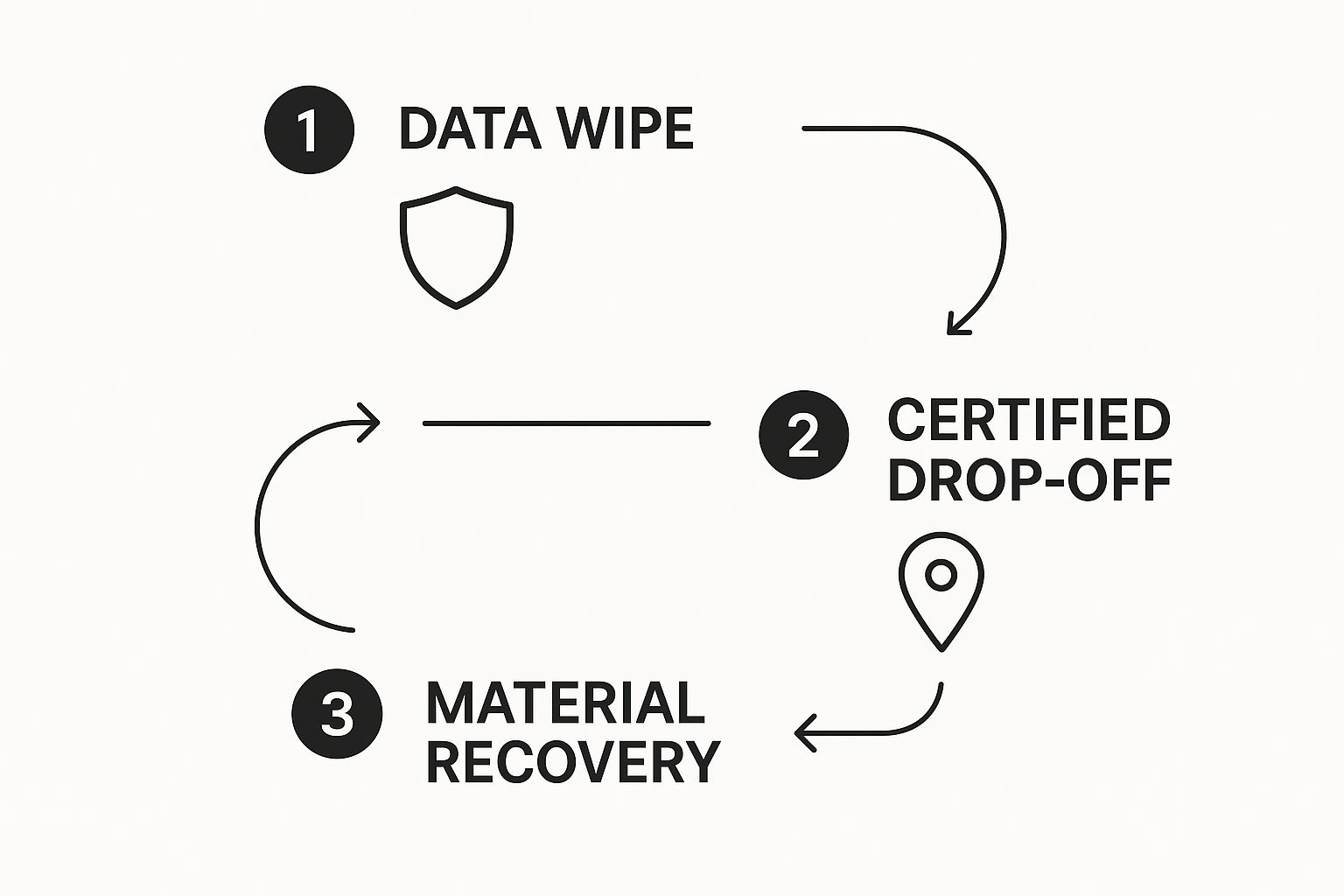
As you can see, it's a simple flow: protect your data, find a proper drop-off location, and let the recycling process begin.
Finding the Right Place to Recycle
Finding a good drop-off spot is your final, vital task. The scale of the e-waste problem is mind-boggling, making this step more important than ever. Back in 2022, a shocking 62 million tonnes of e-waste were created worldwide, but only about 22.3% of it was actually collected and recycled properly. That huge gap means a massive loss of resources and a serious environmental risk. You can dig into these global e-waste trends to see just how important better recycling is.
Here’s a quick-reference table to help you figure out where to take common electronics.
Where to Recycle Common Electronics
| Device Type | Best Recycling Option | Things to Remember |
|---|---|---|
| Smartphones & Tablets | Manufacturer take-back programs (like Apple's) or certified e-waste recyclers. | Always wipe your personal data! These hold the most sensitive information. |
| Laptops & Computers | Stores like Best Buy or Staples. Also check for local e-waste collection events. | Don't forget to remove the hard drive if you're worried about data. Some recyclers offer certified data destruction. |
| Batteries (all types) | Call2Recycle drop-off locators or special bins at home improvement or electronics stores. | Never throw batteries in the trash. They are a fire hazard and contain toxic materials. |
| Cables & Chargers | Often accepted at the same places that take phones and laptops. Group them together. | They contain valuable copper that can be easily recovered. |
This table is a great starting point, but don't stop there. Here are a few other reliable options to look into:
- Manufacturer Programs: Most major tech companies, including Dell and HP, have their own mail-in or drop-off recycling programs.
- Local E-Waste Events: Keep an eye on your community calendar. Towns often host collection events a few times a year, which makes things super easy.
- Third-Party Certifiers: Websites like e-Stewards or R2 Solutions are fantastic resources. They keep lists of certified recyclers so you can find a trusted one near you.
Taking the time to recycle correctly is the final piece of the puzzle in learning how to reduce electronic waste. It ensures that even at the very end of its life, your device helps create a circular economy instead of just becoming another problem in a landfill.
Easy Habits to Make Your Devices Last Longer
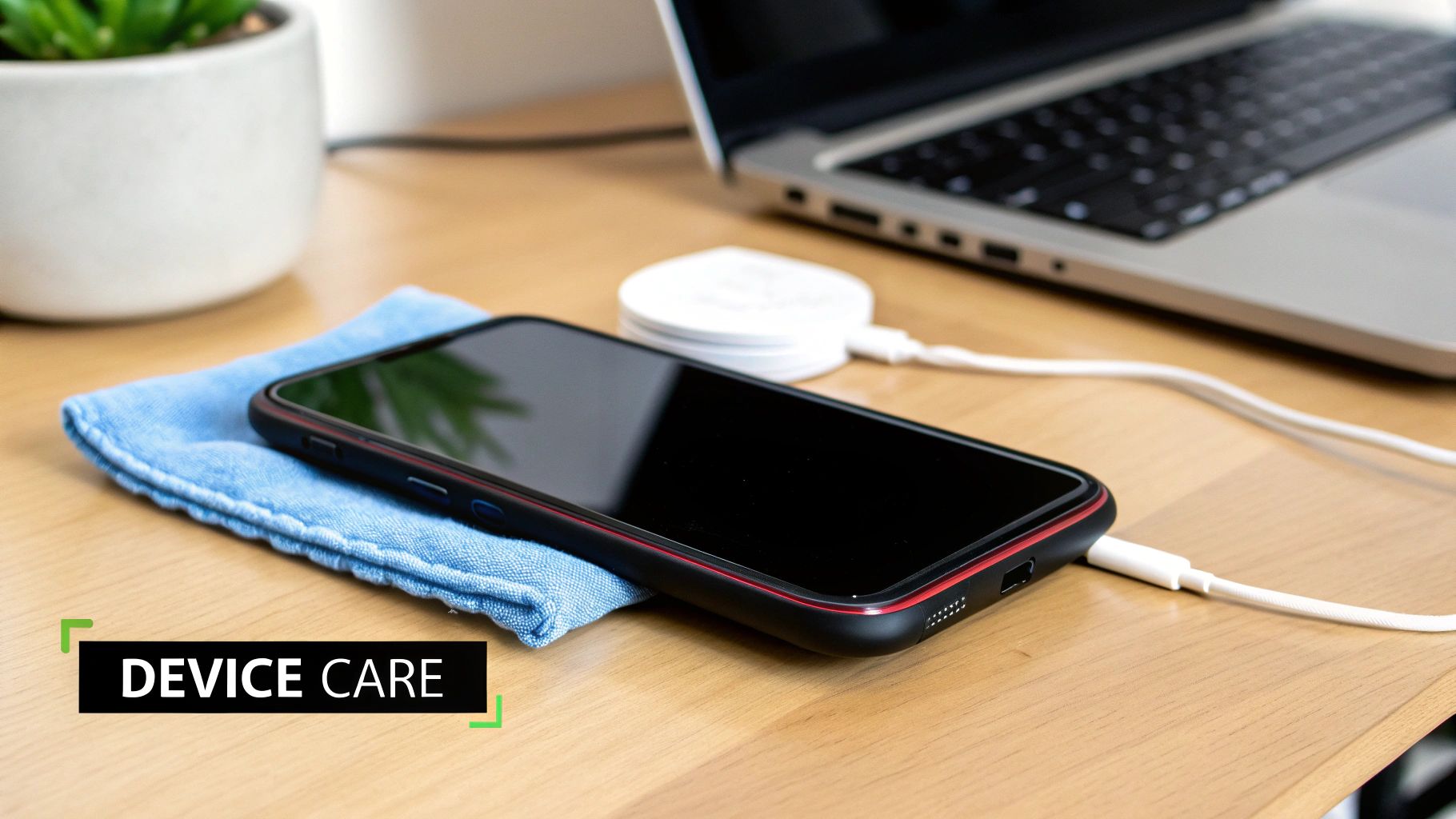
One of the best ways to fight electronic waste is to simply get more life out of the gadgets you already own. It's surprising how big of a difference it makes—just making your phone or laptop last another year can significantly cut down your environmental impact.
You don't need to be a tech expert to do this. A few small, consistent habits can add years to a device's life, pushing back the need for a replacement.
The easiest place to start is with basic physical protection. A good case and a screen protector are small investments that prevent the kind of accidental drops and scratches that send a perfectly good device to an early retirement.
Master Your Battery Health
Let's be honest, the battery is almost always the first thing to go. But you have a lot more control over its lifespan than you might think. The biggest killer for modern batteries is a combination of heat and being left at a 100% charge for a long time, like overnight. This puts the battery under constant stress, and it wears out way faster than it should.
A much better approach is to keep the battery level somewhere between 20% and 80%. It’s a simple change, but it dramatically slows down the aging process.
Key Takeaway: Think of your battery less like a gas tank that needs to be filled to the top and more like something that prefers to stay comfortable. Avoiding those extreme highs and lows is the single best thing you can do for its long-term health.
If you want to really dig in, you can learn more about how to properly maintain your phone's battery health with these tips and see a real difference. There are even smart charging tools that can handle this whole process for you, so your battery is always getting the best treatment.
Keep Things Clean Inside and Out
Just like any tool, your electronics work better when they're well-maintained. This goes for both the physical device and the software running on it.
Physical Cleaning:
- Ports and Vents: Lint and dust get stuck in charging ports and laptop vents, causing connection problems and overheating. Every few months, take a soft brush or a bit of canned air and gently clean them out. You'll get a better connection and airflow.
- Screen and Body: Give your devices a regular wipe-down with a microfiber cloth. It removes grime that can build up and wear down the finish over time.
Software Cleanup:
- Delete Old Apps: Get rid of any apps you haven’t opened in months. Many run in the background, eating up battery and slowing your device down.
- Clear Your Storage: When your phone or computer gets close to full, everything feels slow. Make a habit of moving photos to the cloud or an external drive and clearing out files you no longer need.
Of course, accidents can still happen. The key is knowing what to do. For example, if your phone gets wet, don't fall for the old "put it in rice" trick. Instead, learn about proper liquid damage recovery to give it the best chance of survival. These small habits add up, keeping your devices feeling quick and new for much longer.
Your Top E-Waste Questions, Answered
Even when you're trying to do the right thing, figuring out how to reduce electronic waste can feel a bit confusing. Let's tackle some of the most common questions I hear, so you can move forward with confidence.
"Can I just toss small electronics into my regular recycling bin?"
I get this one a lot, and the answer is a firm no. Your home recycling is set up for simple stuff like paper, glass, and certain plastics—not complex gadgets.
Think about what's inside a phone or a tablet: it's a mix of valuable materials and some pretty harmful stuff, like lead and mercury. These devices need a special disassembly process that your local recycling plant just isn't built for. Tossing them in the wrong bin can actually ruin an entire batch of otherwise good recyclables.
"Is It Safe to Donate or Recycle Old Devices with My Data on Them?"
This is a huge one, and for good reason. The short answer is no, it's not safe—unless you take action first. Before any device with storage leaves your hands (a phone, laptop, even a smart TV), you absolutely have to wipe your personal information clean.
A factory reset is a decent first step, but honestly, it’s not always enough. For real peace of mind, find your device’s built-in secure erase option or use a trusted data-wiping program. This process writes over your old data, making it practically impossible for someone else to find it. It only takes a few extra minutes, and your privacy is worth it.
Your personal data is your responsibility right up until the moment a device is properly recycled. Taking the time to permanently erase it is the most important step before donating, selling, or recycling.
"Does Buying Refurbished Really Make a Difference?"
It makes a massive difference. Seriously, choosing a refurbished device is one of the most powerful things you can do. Every time you buy a renewed product, you're directly telling manufacturers you don't need a brand-new one.
The positive effect is huge. You’re saving the precious metals and energy that would have been used for new production. Just as importantly, you’re stopping a perfectly good device from ending up in a scrap heap way too soon. It’s a win for your wallet and an even bigger win for the planet.
Here are a couple of other quick-fire questions that pop up all the time:
- What about my box of old cables and chargers? Yes, those are e-waste, too! Certified recyclers love these. They’re full of valuable copper that’s easy to get back and reuse.
- Should I repair or replace my broken device? My rule of thumb is this: if a repair costs less than half the price of a new device, it's almost always the smarter, more sustainable choice. A simple battery swap or screen replacement can easily double a gadget's lifespan.
By getting clear on these practical points, you can build a solid plan. Every little choice—from fixing a cracked screen to finding a certified recycler for an old laptop—really does add up.
The single most effective way to cut down on e-waste is to make your devices last longer, and that starts with the battery. Chargie is a little device I use that stops my phone from overcharging overnight, which is one of the biggest killers of battery health. By smartly managing your charge levels, Chargie can help you get up to four times more life out of your phone or laptop battery. That means saving money and keeping electronics out of the landfill. You can learn more and get yours on the Chargie website.
Article created using Outrank

